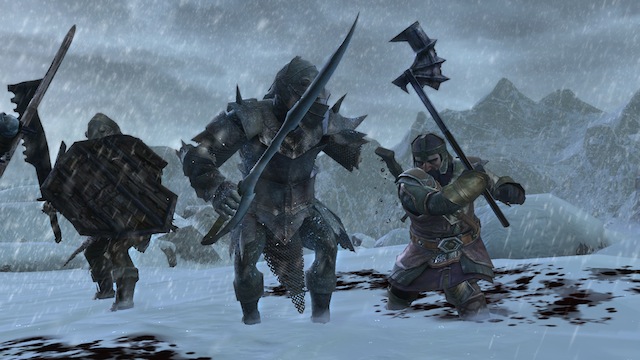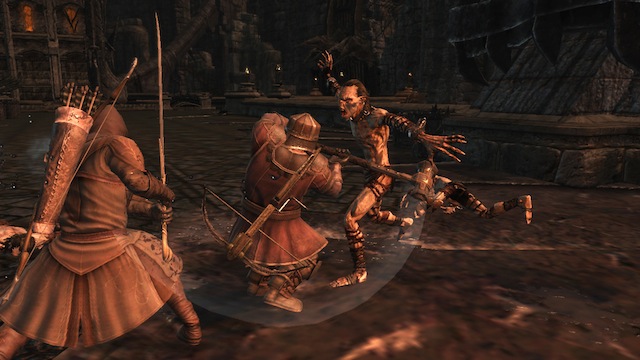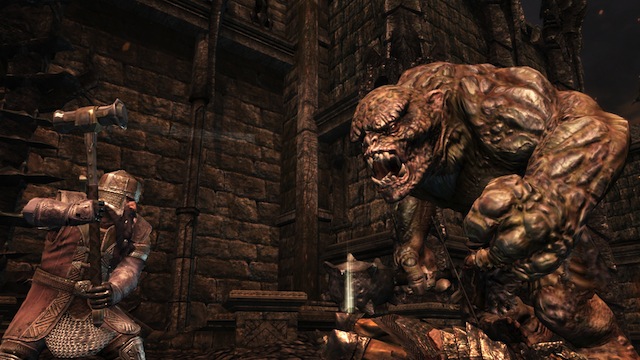The Lord of the Rings: War in the North Review
 Game: The Lord of the Rings: War in the North
Game: The Lord of the Rings: War in the North
Developer: Snowblind Studios
Publisher: WB Games
Available on: PlayStation 3, Xbox 360, PC, OnLive (Reviewed on Xbox 360)
We all know what happened when Frodo Baggins, a simple Hobbit from the Shire, came into possession of The One Ring, we all know the adventure that he, and his eight companions, took through the peaks and valleys of Middle-earth on their way to Mount Doom in the lands of Mordor, but there is a story that we aren’t aware of. Doesn’t it seem a little odd that Frodo and his friends didn’t have to face too much opposition for a lot of the time? Well, it would seem that that’s because Sauron’s gaze was firmly fixed on the north, on another fellowship, one that was attempting to distract the Dark Lord from The One Ring while also destroying the forces of Agandaur, one of Sauron’s chief lieutenants in the process.
The Lord of the Rings: War in the North is the story of that journey, a journey of hope and destruction, a journey that, if the story is to be believed as canon, enabled the success of Frodo’s own quest to destroy The One Ring.
Things aren’t going to be easy.
This game is available for a 30 minute demo via OnLive, by clicking the banner below:
STORY: When you’re working for a piece of work that’s as in depth as The Lord of the Rings then you’re sure to be able to pick a story or two from within the pages. That’s exactly what the people over at Snowblind Studios did when they thought up the idea of The Lord of the Rings: War in the North, create a story that isn’t a part of The Lord of the Rings as it currently stands but fits seamlessly together with the work that we all know and love; and they’ve done a good job of it too.

The story revolves around three adventurers, Farin, Eredan and Andriel who are tasked by Aragorn to distract Sauron and direct his attention towards them in order to help Frodo and the Fellowship of the Ring attempt to slip by unnoticed. That’s the plan anyway. For the most part the story told within War in the North does well to sit seamlessly with the story that we already know and love as long as you hold a certain suspension of disbelief, you are playing a fantasy game after all. It’s easy to question why you’re only getting to hear about this band of fighters now if they played such an integral part of the destroying of The One Ring but, for people that get their kicks from simply being inside the world that Tolkien created, it’s an easy aspect of the story to overlook.
GRAPHICS: The graphics in The Lord of the Rings: War in the North is powered by a massively updated version of the Dark Alliance Engine, also known as the Snowblind Engine. This is an engine that’s created and developed by the developers of the game and so if anyone knows how to put the engine to the limit, it’s Snowblind themselves. The graphical power of the Dark Alliance Engine is clear to see, all of the characters are rendered with care and attention, even down to the fact that items of clothing will get torn and battered after a few battles, and every piece of equipment that you might find lying around looks legendary when wielded.
The graphics engine really comes into its own in places such as the Barrow-Downs, where the players start on high ground and are able to look down over the landscape, seeing places that they’ve ready about in the books and maybe glimpsed for seconds in the Peter Jackson films. That’s where The Lord of the Rings: War in the North really comes into its own, walking along pathways that you’ve read about, and visiting places that you’re familiar with, the Snowblind Engine does a lot to help sell the immersion.

SOUND: The sound in The Lord of the Rings: War in the North is one of the parts of the game that really got to me, and not in good way. While all of the music that’s used throughout the game is suitably epic for a story taking place in Middle-earth, almost all of the voice acting that is used is, quite frankly, terrible. At the start of the game the player is given the choice of which character they want to play through the game as (this can be changed at the end of each area) and I chose to play as Farin, the dwarf. This was a decision that I instantly regretted the moment that I heard him talk as he has one of the worst American/fake Scottish accents I’ve ever heard. It’s not just isolated to this one character though, I would have been able to tolerate that, all of the characters that you’ll meet are just as bad, with the exception of Gandalf who sounds Gandalf-esque throughout.
The main problem with the terrible voice-acting is that Snowblind Studios have made all the familiar characters look like the actors that played them in the movies. Aragorn looks like Viggo Mortensen, Elrond Halfelven looks like Hugo Weaving and so forth. This makes it hugely more off-putting when a voice comes out of their mouth that you don’t associate with their face. It takes the player totally out of the story and, for a game that rests on the strength of its story, that’s a bad thing.
GAMEPLAY: The main crux of the gameplay, the combat, revolves around the basic hack and slash gaming principals of grabs the biggest weapon in the room and whack the biggest enemy with it until it’s dead. This works quite well in the fantasy setting of The Lord of the Rings and, coupled with the RPG elements of the game, lead to some quite fulfilling gameplay moments. There’s no doubt that hacking and slashing away at an enemy until a little yellow triangle appears and then hitting the heavy attack button to launch a devastating move is one of the best feelings I’ve had in a game to date. The combat system isn’t deep, it’s not even particularly varied, but it’s enjoyable. It reminds me very much of Viking: Battle for Asgard in the sense that the combat mechanics can get a little repetitive and simplistic but if you enjoy the guttural, primal nature of them, then you’re going to have fun no matter what.

Another aspect of the game that forces it to lean more towards the RPG side of things rather than the traditional hack and slash game is the levelling system. Every time you take down an enemy you will be rewarded with experience points (XP) and this XP will enable whichever character you’ve chosen to play as, to level up, getting stronger and allowing them to access a couple of special abilities suitable to their class. If you’ve played World of Warcraft before, or just about any RPG that uses the talent tree system, then you’ll feel instantly at home with the method that The Lord of the Rings: War in the North uses. Players will instantly want to drill down into a single tree in order to get the fourth tier goodies, but it’s those players that take their time choosing where they’re going to be spending those special little talent points that will be able to get the most out of their class.
If you’re the type of gamer who gets a little bit bored of the same old thing after a while then there are options available to you in The Lord of the Rings: War in the North, options in the form of challenges. In these challenges the players have to defeat a horde of enemies of an ever increasing difficulty. The player will take on five waves of enemies, ranging from the ones that take one hit to take down, to those that take a little bit more skill in order to best. Once the five waves have been completed the boss wave starts. The boss wave is very similar to the waves that have come before only with a little extra added difficulty in the form of a troll or an orc chief. Once you’ve beaten this boss round the chests that you previously collected will be refilled and ready to be collected again and you move on to another five waves. This can be repeated over and over again, getting better and better items every time the chests are refilled, until you want to go back to the story; at which point you simply leave the area.
Where a lot of people will get the most fun out of The Lord of the Rings: War in the North is when it comes down to the multiplayer, get a few friends round, sit back and pick your character for a long gaming session with a gorgeous backdrop of gorgeously rendered Middle-earth. Players can choose to be either Eredan, Farin or Andriel, characters that are vastly different from each other but can be rather adaptable. This means that if the only character left to choose is Andrial, but you want to get up close and personal with some hacking and slashing, then there’s nothing stopping you. A lot of the fun comes from playing the game in multiplayer, and it can be played either online or locally, but as with most things playing games together is much better in person.

LONGEVITY: The main game is quite long, there are 8 chapters in total and each chapter alone can usually take up to a couple of hours to complete, as with any RPG though, how long you spend inside the game depends entirely on how much you do within it. If you spend time to complete the side quests, then you’re extending your game time, if you choose to smash all of the breakable objects in the game in order to collect as much treasure as you can possibly carry, then you’re obviously going to extend your total game time further still. With The Lord of the Rings: War in the North, as with almost all other RPG’s, you get out of it what you put in.
VERDICT: With mediocre graphics and terrible voice-acting it would be easy to dismiss The Lord of the Rings: War in the North as just another game that simply couldn’t cut it in the lands of Middle-earth, but Snowblind Studios did a good job of making the player feel like they were a part of Middle-earth, as if they were helping to change the course of history and that is not an easy thing to do; not with a story as massive as The Lord of the Rings anyway. The gameplay is fun for the most part, but can get a little repetitive at times and that’s disappointing, but it’s nice to see a Lord of the Rings game with an M rating, targeting it squarely at the people who love the franchise, the people the grew up reading the books and watching the films, the people that are almost certainly all over 20 by now.






